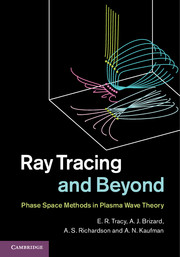Book contents
- Frontmatter
- Dedication
- Contents
- Preface
- Acknowledgements
- 1 Introduction
- 2 Some preliminaries
- 3 Eikonal approximation
- 4 Visualization and wave-field construction
- 5 Phase space theory of caustics
- 6 Mode conversion and tunneling
- 7 Gyroresonant wave conversion
- Appendix A Cold-plasma models for the plasma dielectric tensor
- Appendix B Review of variational principles
- Appendix C Potpourri of other useful mathematical ideas
- Appendix D Heisenberg–Weyl group and the theory of operator symbols
- Appendix E Canonical transformations and metaplectic transforms
- Appendix F Normal forms
- Appendix G General solutions for multidimensional conversion
- Glossary of mathematical symbols
- Author index
- Subject index
- References
6 - Mode conversion and tunneling
Published online by Cambridge University Press: 05 April 2014
- Frontmatter
- Dedication
- Contents
- Preface
- Acknowledgements
- 1 Introduction
- 2 Some preliminaries
- 3 Eikonal approximation
- 4 Visualization and wave-field construction
- 5 Phase space theory of caustics
- 6 Mode conversion and tunneling
- 7 Gyroresonant wave conversion
- Appendix A Cold-plasma models for the plasma dielectric tensor
- Appendix B Review of variational principles
- Appendix C Potpourri of other useful mathematical ideas
- Appendix D Heisenberg–Weyl group and the theory of operator symbols
- Appendix E Canonical transformations and metaplectic transforms
- Appendix F Normal forms
- Appendix G General solutions for multidimensional conversion
- Glossary of mathematical symbols
- Author index
- Subject index
- References
Summary
Introduction
As already mentioned in earlier chapters, the eikonal approximation can become invalid in local regions of the plasma. The most common problems are caustics (see Chapter 5), tunneling, and mode conversion. Both tunneling and mode conversion are processes where one incoming ray splits into two outgoing rays, a transmitted ray and a converted ray. The matched asymptotic methods are therefore more complicated than for caustics. Tunneling concerns only one eigenvalue of the N × N dispersion matrix, while mode conversion entails two. It follows that tunneling involves only one polarization, while mode conversion is associated with a pair. Therefore, tunneling can be reduced by Galerkin projection locally to a scalar formulation, while mode conversion is inherently a vector problem. An important point we should emphasize is the following: For caustics, it is always possible to find a local representation where the eikonal approximation is valid. In contrast, in tunneling and mode conversion regions, there is no representation in which the eikonal approximation is valid. It is only when we consider points far from the conversion region that we recover eikonal behavior. This leads to two important questions:
If the eikonal approximation is not valid within the conversion region, why persist in using ray tracing there?
Although the eikonal approximation is valid for the incoming wave field (by assumption), what justifies the assumption that the transmitted and converted wave fields become eikonal once more?
- Type
- Chapter
- Information
- Ray Tracing and BeyondPhase Space Methods in Plasma Wave Theory, pp. 228 - 326Publisher: Cambridge University PressPrint publication year: 2014



